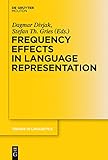Frequency Effects in Language. Volume 2, Frequency Effects in Language Representation / ed. by Dagmar Divjak, Stefan Th. Gries.
Material type: TextSeries: Trends in Linguistics. Studies and Monographs [TiLSM] ; 244.2Publisher: Berlin ; Boston : De Gruyter Mouton, [2012]Copyright date: ©2012Description: 1 online resource (282 p.)Content type:
TextSeries: Trends in Linguistics. Studies and Monographs [TiLSM] ; 244.2Publisher: Berlin ; Boston : De Gruyter Mouton, [2012]Copyright date: ©2012Description: 1 online resource (282 p.)Content type: - 9783110273786
- 9783110274073
- 410.1/51 23
- P128.F73 F78 2012
- online - DeGruyter
- Issued also in print.
| Item type | Current library | Call number | URL | Status | Notes | Barcode | |
|---|---|---|---|---|---|---|---|
 eBook
eBook
|
Biblioteca "Angelicum" Pont. Univ. S.Tommaso d'Aquino Nuvola online | online - DeGruyter (Browse shelf(Opens below)) | Online access | Not for loan (Accesso limitato) | Accesso per gli utenti autorizzati / Access for authorized users | (dgr)9783110274073 |
Frontmatter -- Preface -- Table of contents -- Introduction -- Things going unnoticed – A usage-based analysis of go-constructions -- The Locative Alternation and the Russian ‘empty’ prefixes: A case study of the verb gruzit’ ‘load’ -- Alternation biases in corpora vs. picture description experiments: DO-biased and PD-biased verbs in the Dutch dative alternation -- A unified lexicon and grammar? Compositional and non-compositional phrases in the lexicon -- Measuring Mental Entrenchment of Phrases with Perceptual Identification, Familiarity Ratings, and Corpus Frequency Statistics -- Figurative extensions of word meaning: How do corpus data and intuition match up? -- Conversion and the lexicon: Comparing evidence from corpora and experimentation -- As lexical as it gets: The role of co-occurrence of antonyms in a visual lexical decision experiment -- Subject index
restricted access online access with authorization star
http://purl.org/coar/access_right/c_16ec
The volume explores the relationship between well-studied aspects of language (constructional alternations, lexical contrasts and extensions and multi-word expressions) in a variety of languages (Dutch, English, Russian and Spanish) and their representation in cognition as mediated by frequency counts in both text and experiment. The state-of-the-art data collection (ranging from questionnaires to eye-tracking) and analysis (from simple chi-squared to random effects regression) techniques allow to draw theoretical conclusions from (mis)matches between different types of empirical data. The sister volume focuses on language learning and processing.
Issued also in print.
Mode of access: Internet via World Wide Web.
In English.
Description based on online resource; title from PDF title page (publisher's Web site, viewed 28. Feb 2023)


